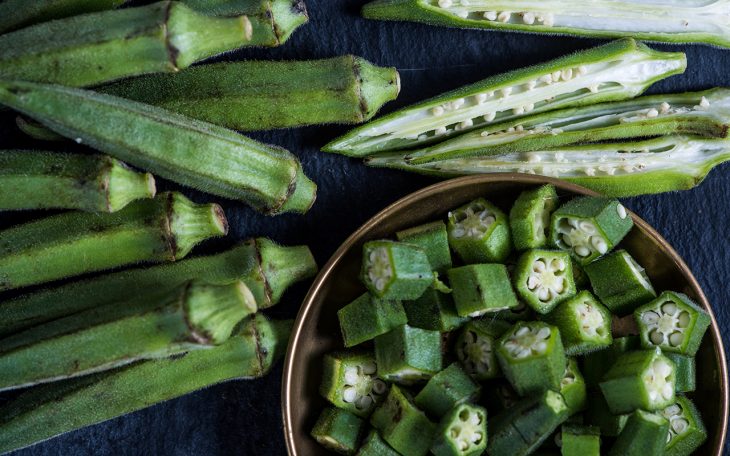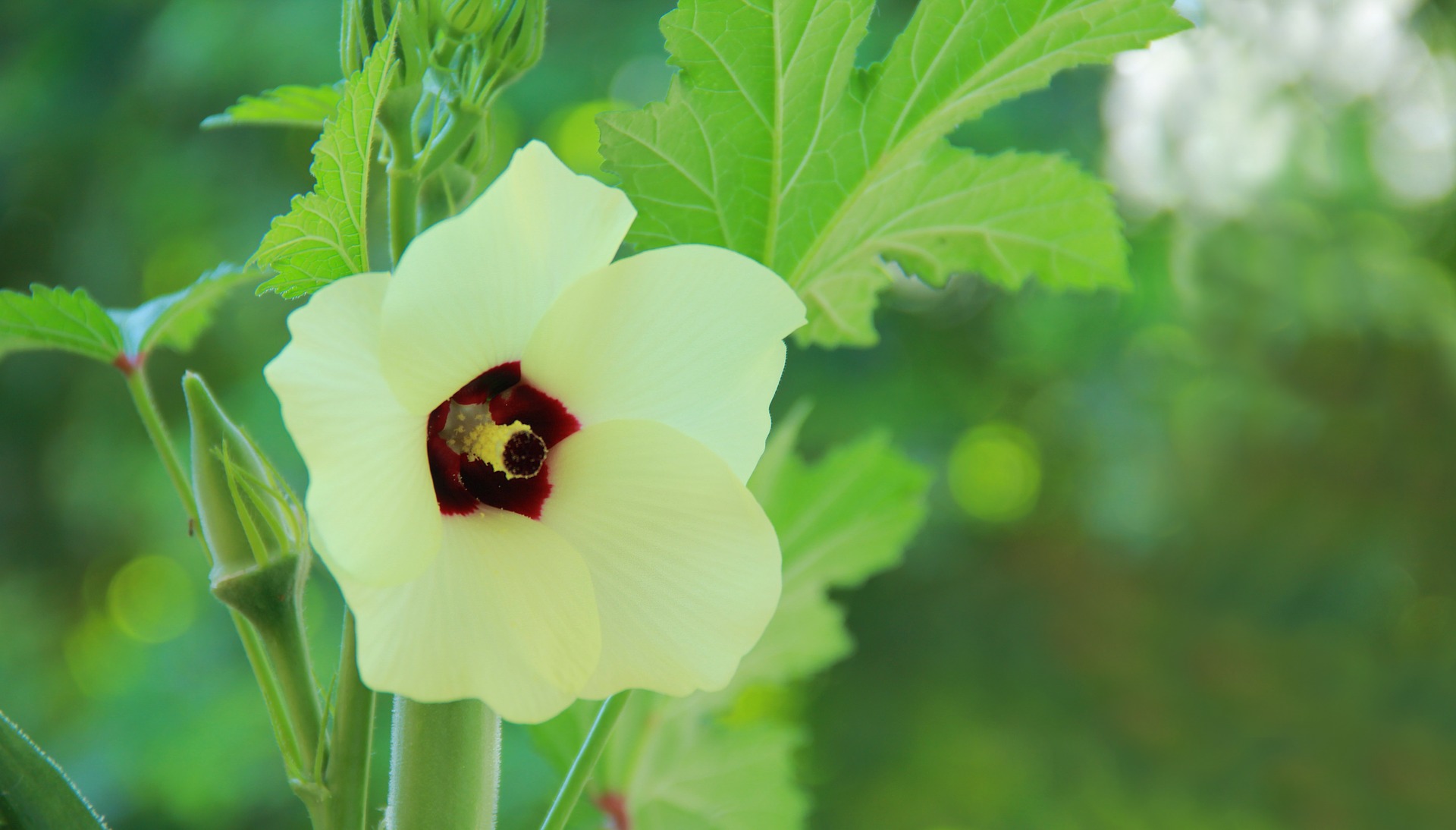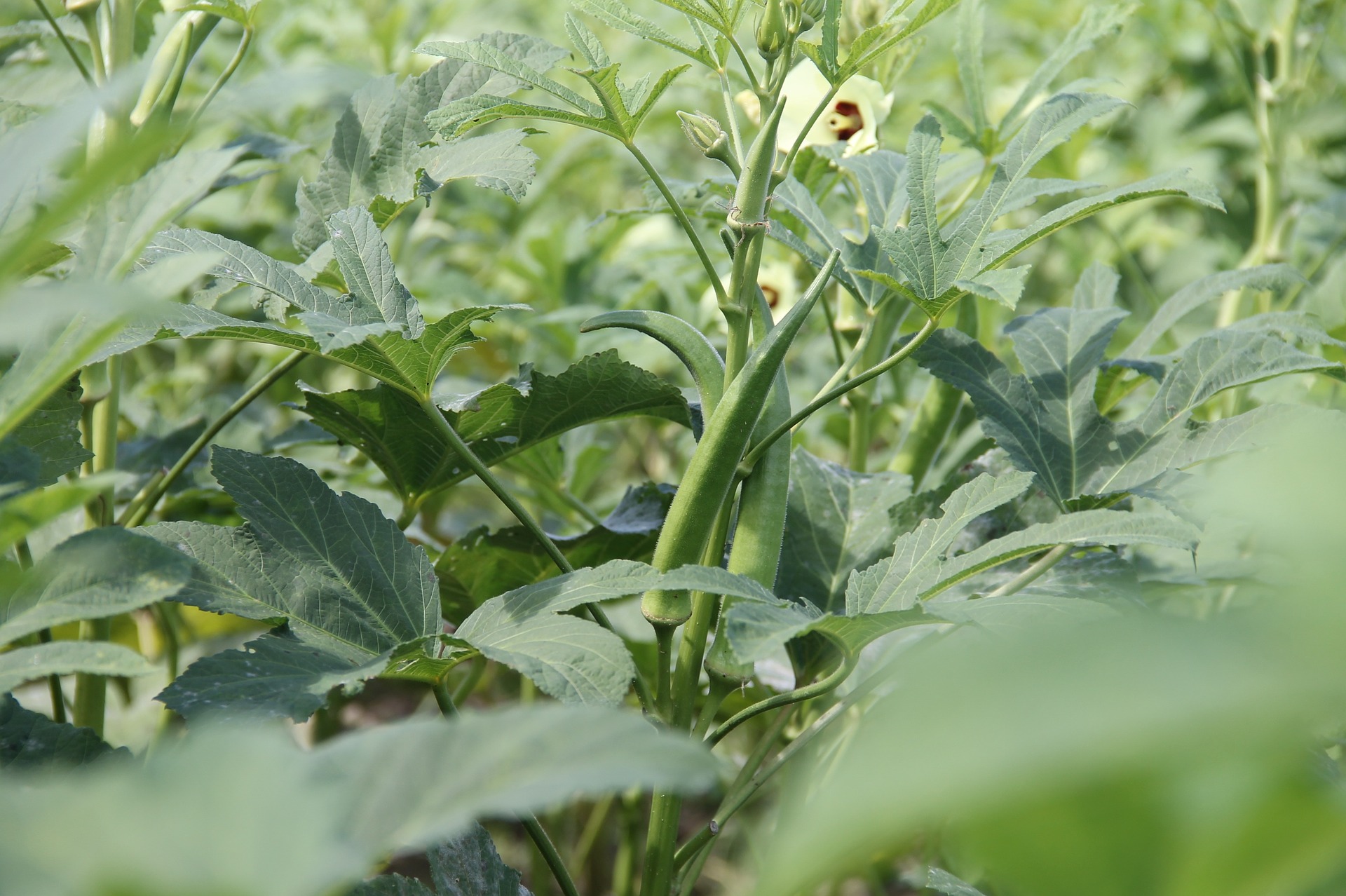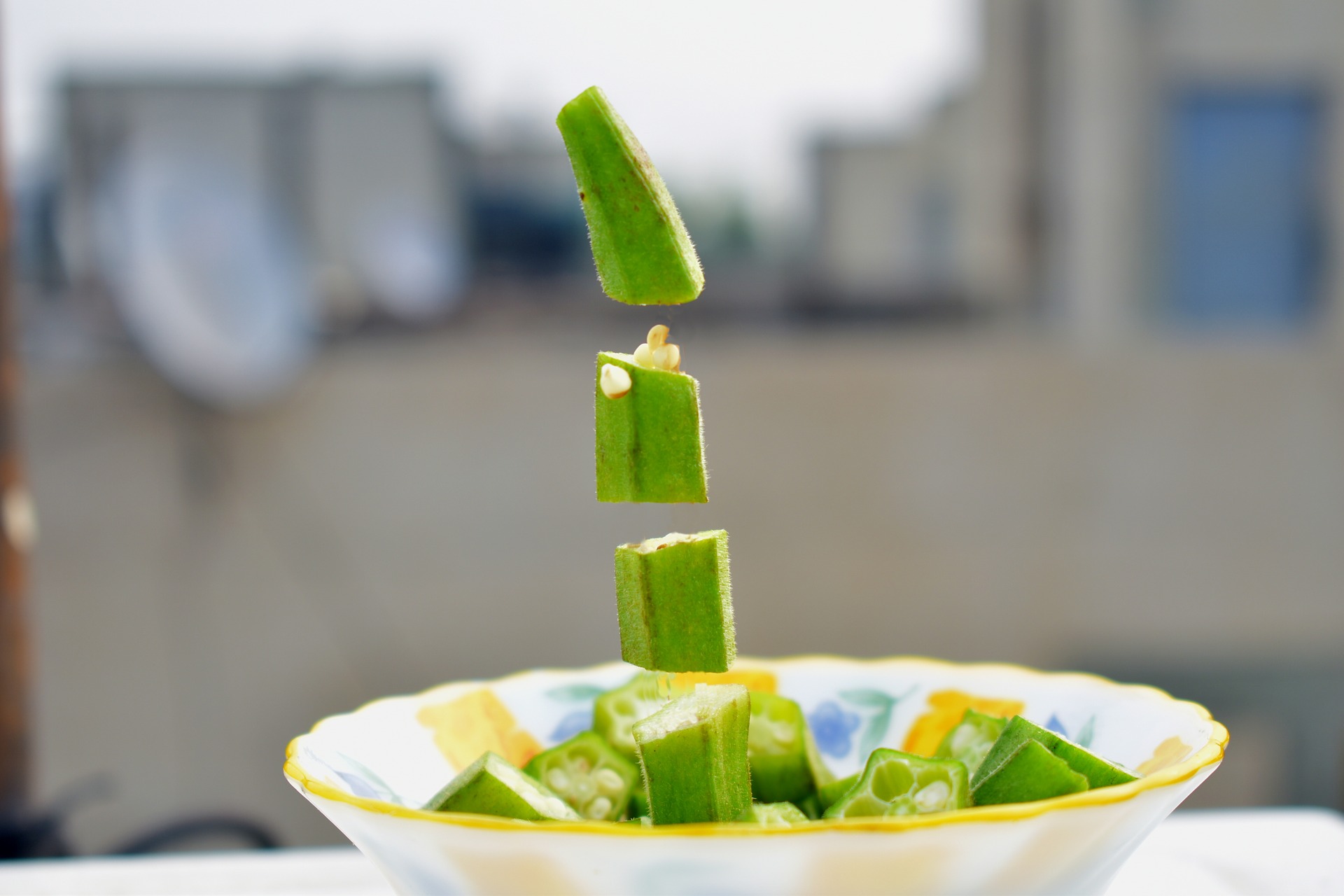
Okra is a plant that many cultures regard as a culinary treasure. This plant is particularly famous in the Southern regions of the United States, where it’s a thickening agent for the much-loved gumbo. Although it’s an invaluable food source for many, some people might find it hard to get past its slimy texture. Love it or hate it, however, this plant has certainly risen to popularity as food and as a multi-functional plant. Learn more about its history, health benefits, and other fun information with these outstanding okra facts.
- These plants are perennials, meaning they can live for more than two years.
- Its plants are fairly tall and can reach heights of 6.6 ft (2 m).
- Its seeds germinate between around six days to three weeks.
- The plants grow best at soil temperatures of at least 68 °F (20 °C).
- Their fruits are long and grow around 3 to 10 inches (7.62 – 25.4 cm) in length.
- Okra has multiple alternate names such as okro, ochro, gumbo, bhindi, quimbombó, or ladies’ fingers.
- The scientific name of okra is Abelmoschus esculentus.
- The term esculentus in its species name is Latin for “edible” or “fit for consumption”.
- The okra plant has edible seed pods.
- It often grows in warm areas of the world, such as tropical, subtropical, and warm temperate regions.
- The term okra originates from the Igbo word ọ́kụ̀rụ̀.
- This plant is hardy and can tolerate a wide range of environmental conditions such as drought and heavy clay. It’s not resistant to frost, however.
- The fruits have hairlike structures on their skins resembling the fuzz of peaches.
- When cut in cross-sections, the fruits are pentagonal in shape.
- The fruits are fit for human consumption when they’re still immature.
- Raw okra is 90% made up of water and is low in calories. Per 3.5 oz (100 g), they only have 33 kcal (138 kJ).
- It doesn’t always require cooking, because even raw okra is safe to eat.
- Because truly wild okras are hard to find, experts believe that okra could be a result of human cultivation.
- Scientists suggest that okra oil could have the potential to become a form of biodiesel.
- Although they’re cooked like vegetables, the pods are actually fruits.
Okra seeds can be a great substitute for coffee.
One of the most interesting facts about okra is that its seeds can be a substitute for coffee. You can dry, grind, and roast the seeds to make a replacement for coffee, and the taste is reportedly not that far off from traditional coffee. The best part is that unlike the ones made from actual coffee grounds, this okra coffee is caffeine-free and won’t keep you up at night.
A popular account of this okra-based coffee is one by Dr. N.B. Cloud, whose words were published in The Daily Journal (Wilmington, N. C.). This account was published in 1863, in the midst of the American Civil War. During this period, coffee was scarce and expensive, so people began looking for possible alternatives. It turns out that mature okra seeds proved to be the best substitute they could find. These plants were cheap and easy to cultivate and harvest, after all, leaving coffee lovers satisfied without breaking the bank.
The origins of okra aren’t too clear.
Written accounts about okra have been present as early as around the 12th century, but experts don’t seem to reach an agreement on where exactly these plants originated. Popular theories on its origins point to East Asia, West Africa, or Ethiopia. In the 12th and 13th century, the Moors and Egyptians referred to the plant as bamya, an Arabic word. This suggests that it arrived in Egypt from Arabians. Some evidence points out, however, that the Arabians got the plants from Ethiopia. They might have transported the plants from Ethiopia to the Arabian peninsula through the strait of Bab-el-Mandeb or the Red Sea.
The Atlantic slave trade brought the plants to the Americas, where the earliest accounts say that they thrived in Brazil by 1658. A few decades later, accounts reported that they also began flourishing in Suriname. The plants also arrived in southeastern North America by the early 18th century, coming all the way from Africa. In 1781, Thomas Jefferson stated that the plant was already thriving in Virginia. The plant became a common vegetable in the Southern United States by the year 1800. It also already had different documented varieties by 1806.
Okras often feel slimy when cooked.
One of the biggest drawbacks of okra for many people is that the seed pods can have a rather slimy or gooey texture when cooked. This may be unpleasant for some and can certainly throw off unwitting palates.
Why is okra so slimy, then? The reason why okras feel slimy when cooked is that these plants are mucilaginous — the pods of these plants contain slimy substances that are mainly made up of complex carbohydrates (such as galactose, rhamnose, and galacturonic acid) as well as some proteins. This mucilage or gel-like substance is also present in plants like flaxseed (Linum usitatissimum) and yellow mustard (Sinapis alba), but okras have a notably high amount of mucilage.
For some people, this mucilage is one of okra’s more desirable characteristics, but a lot of people would prefer to eat it without the slime. To reduce its slimy texture, you can cook it alongside acidic ingredients such as tomatoes, lemon, or vinegar. Moreover, cooking it quickly (as in grilling and deep-frying) can also help in bringing down the slime.
Okra is a popular thickener for soups, stews, and sauces.

Okra’s slime may not be the best texture on its own, but it does have its own unique uses. In fact, this characteristic slime makes it a key ingredient in many soups, stews, and sauces. A notable example of this is gumbo, a favorite dish in the Southern United States. Heating it for a longer period of time makes the mucilage more viscous, giving the sauce a thicker texture.
It’s high in vitamins and minerals.
Despite being low on calories, okra is a rich source of vitamins and minerals. It’s high in vitamin C and vitamin K, which can help protect the body against scurvy, immune deficiencies, and uncontrolled bleeding. Just 100 grams of okra can meet 28% of the Daily Value for vitamin C and 30% for vitamin K. It’s also a great source of magnesium, potassium, and manganese.
It is rich in important antioxidants.
Free radicals are highly reactive molecules that can cause cell damage, leading to the development of various diseases and even aging. Our bodies naturally encounter free radicals in our everyday lives, but we also have ways to combat their damaging effects. Antioxidants, for example, can neutralize free radicals and stop them from damaging our cells. The human body can make its own antioxidants, but diet can also play a significant role in getting these important compounds. Another great aspect of okra is that it is a rich source of flavonoids and isoquercetin, which are antioxidant compounds. This means that this slimy yet helpful food can help protect against the cell damage that free radicals can cause.
It could have implications for diabetes treatment.
Not only is okra highly nutritious, but it also has multiple other medicinal implications. Research on okra’s effects on blood sugar levels in laboratory animals has promising results, and scientists are still currently in the process of finding its implications for diabetes treatment in humans. In one recent study, however, scientists found that some compounds in okra can help in the management of blood sugar levels. Through these compounds, these outstanding plants can help in slowing down the absorption of glucose by the intestines. By slowing down the rate of glucose absorption, okras can therefore aid in lowering blood sugar levels, which is crucial to those with diabetes. Who knew that this slimy food would be so useful?
Its slime can help treat wastewater.
Wastewater treatment facilities typically use flocculation to clean wastewater and prevent water pollution. In the process of flocculation, waste particles stick to one another into clumps or flocs. The clumps of waste material can then either float to the surface or sink underwater, which the treatment facilities can then filter out before releasing the water back to rivers or the sea. Studies show that the slime of okra can help facilitate this process and even rivals commercial flocculants when it comes to its effectiveness. Truly a neat fact about this outstanding plant!
It can be key to biodegradable food packaging.
Okras are eco-friendly in more ways than one. Their characteristic slime can one day pave the way to biodegradable and sustainable food packaging. In some studies, researchers made thin films out of okra mucilage and corn starch. They then discovered that these films made out of the slime of okras have the potential to replace plastic food packaging. These biodegradable films are compact, low in solubility, and non-toxic, giving them significant advantages over plastic food packaging.
Okra is related to hibiscus, cacao, and cotton.
Okras are plants that are part of the mallow family (Malvaceae). This family is vast and has over 4,000 known species, many of which are important to humans. Among the popular members of this family are hibiscus, hollyhock, cacao, cotton, and durian. The marsh-mallow plant (Althaea officinalis), from which marshmallow treats originate, is also a notable part of this plant family.
Okra’s specific parentage still remains unclear to scientists, with some saying they came from Abelmoschus ficulneus, while others postulating that they branched off from Abelmoschus tuberculatus.
The okra plant grows flowers that look similar to hibiscus flowers.

Perhaps one of the okra facts that many people aren’t aware of is that they grow bright and beautiful flowers. The flowers resemble the flowers of their close relatives, the hibiscus. In fact, the biologist Carl Linnaeus classified okras as Hibiscus esculentus.
Okra is high in fiber.
Okras are rich in dietary fiber, which has a multitude of benefits for digestion. Its mucilage or slime, particularly, is high in water-soluble fiber. This type of dietary fiber is helpful for easing digestion, promoting a healthy gut, and relieving constipation. People who are aiming for weight loss can also benefit from this type of fiber because it helps in making people feel fuller after meals, reducing the need to eat more. Certainly one of the most important okra facts for those who want to be more conscious of their diets!
Most parts of the plant are edible.
Most parts of the okra plant are edible, including the leaves, flowers, seeds, and stems. You can cook its leaves like dandelion greens, spinach, and beets. Moreover, the leaves are also great for salads and stir-frying.
There are many varieties of the plant.

Okras come in many distinct varieties, such as the Clemson Spineless, Jambalaya, Star of David, and Burgundy. Most of these varieties differ in size, shape, and ideal harvesting days. The pods of okras can either be red or green. Green and red okras don’t differ in taste, and red okras will turn green when cooked.
Okra can be made into flour.
Have you ever looked at okras and wondered if you could make bread with them? Although it sounds unconventional, scientists are studying how to efficiently harvest okra seeds and turn them into flour. Because of their nutritional value, researchers plan to enrich a variety of food with okra flour. They plan to mix it into regular flour to increase the nutrient content and incorporate okra’s many health benefits into the food products that make use of this flour. Research regarding this is still young and under development, however, and there are still issues they have to address regarding how to produce this okra flour at a larger scale.
It helps alleviate malnutrition in developing countries.
In developing countries where nutritious food can be quite scarce, okras are undeniably a valuable source of nutrients. These plants are relatively cheap, have many different uses, and can readily grow in conditions where other vegetables might struggle to thrive. They’re packed with various nutrients and can supplement the diets of many households worldwide. Okras, therefore, are important for alleviating malnutrition and the lack of food security in many developing nations.
We can also use them to make paper and ropes.
One of the most interesting okra facts is that these plants are multi-functional. Not only are most of their parts edible, but we can also use various parts of the plants for purposes other than food. For example, we can make paper and ropes out of the leaves and stems of the plant. Truly a remarkable and underrated plant!
They can help in the prevention of heart disease.
One of the most beneficial aspects of okras is that these wonderful plants can aid in the prevention of heart disease. Researchers found that okras are rich in polyphenols, which can help mitigate the inflammatory markers associated with heart disease. They can also help lower cholesterol levels because their mucilage or slime can bind to cholesterol during digestion. This helps your body excrete cholesterol instead of absorbing it, protecting you from the cholesterol buildup that can lead to heart disease.
Okras can help promote a healthy pregnancy.

This may not come as a surprise to you, but the slew of nutrients in okra can help promote a healthy pregnancy. Folate or vitamin B9 is a crucial vitamin during pregnancy because it can help prevent the development of birth defects in babies, such as spina bifida and other defects of the brain and spinal cord. Your body cannot produce folate on its own, so you must get it from your diet. Many types of food have this essential vitamin, such as broccoli, asparagus, legumes, and okra. Okra is a rich source of vitamin B9 — a cup of okra can provide 15% of your daily needs.
They can be great moisturizers for your skin.
Aside from being rich in vitamins that are good for your skin’s health, okra pods can also act as great topical moisturizers for your skin and hair, much like the beloved Aloe vera plant. You’d have to boil okra first, however, until it’s soft and slimy. After boiling it and letting it cool, you can then mash it and apply it on your skin and hair. This will help your skin and hair feel smoother and more refreshed. Additionally, it may also be effective against pimples and acne!
Was this page helpful?
Our commitment to delivering trustworthy and engaging content is at the heart of what we do. Each fact on our site is contributed by real users like you, bringing a wealth of diverse insights and information. To ensure the highest standards of accuracy and reliability, our dedicated editors meticulously review each submission. This process guarantees that the facts we share are not only fascinating but also credible. Trust in our commitment to quality and authenticity as you explore and learn with us.
